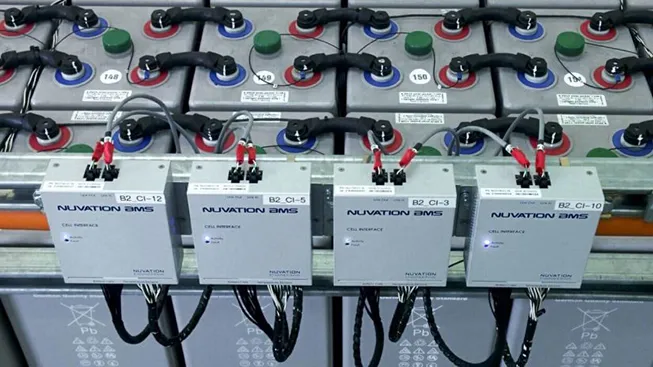June 21, 2017
What Is a Battery Management System?
If you have worked with or looked at battery systems, you have most likely heard of a battery management system or BMS. The term BMS refers to a wide variety of electronic devices that monitor and protect the battery in some way. A battery management system is a battery monitoring device that can take actions to protect the battery from certain usage or other conditions that could damage or shorten the life of the cells.
So why do BMS prices range from $10 to several thousand dollars if they all do the same thing? An appropriate parallel would be to ask why motorized transportation systems vary so greatly in price, with a motorized skateboard at one end of that spectrum, and a transport truck at the other. Let’s take a closer look at how this analogy plays out with battery management systems.
Small Devices
An example at the small end of BMS requirements is what is needed to protect a battery pack for a small device like a cordless drill. The typical cordless drill contains around 5 or 6 cells in series with the total cell cost of about $30. Clearly the BMS must be very inexpensive to maintain market viability; one is typically under $10 and functionality is limited to most basic protection. This BMS would be more accurately referred to as a battery protector. These systems monitor cell voltage and pack current and open one or both back-to-back FETs in the event of voltage or current going out of range. These range limits are fixed at time of manufacture. Over-temperature protection is also sometimes included. These systems often do not include balancing and are standalone, with no communications to other systems.

Moving up a level would be electric bikes, which typically use 36V battery packs. A lithium-ion battery pack for this application is about 0.5 kWh and costs about $200 to $300. Unlike the cordless drill, a longer battery lifespan is important to the customer, and the bike’s total price point is aligned with that expectation, so cell balancing becomes mandatory. The BMS must also be able to connect to some form of “gas gauge” display that shows the user how much power is left in the battery. In addition to this functionality a diagnostic port for service personnel is also desirable. This BMS is around $30 to $50.
Residential Energy Storage Systems
The next level up from these smaller systems to a low-voltage residential energy storage system raises the stakes yet again, this time by an order of magnitude in certain respects. Residential “behind-the-meter” energy storage systems are often in the 48V range, provide 7 kWh-20 kWh, and cost about $5K-$20K.
At this stage balancing performance and monitoring battery parameters must be well implemented and also support the needs of installation and service companies to be able to perform remote monitoring and event logging to manage their customers’ installations (since most home owners are not technically able to manage their own systems).
Service truck rolls are expensive and the availability of remotely accessible information can eliminate many unnecessary calls. This usually means an ethernet interface is required as well as software support such as a browser-based GUI that can be run remotely, and event log pushing to facilitate priority notifications in the event of faults or pending faults. A BMS for this application is typically in the $250 to $500 range.

Mobile Energy Storage
Large mobile power systems for things like electric trucks or boats, mobile energy storage for emergency power, or power for the living space of a mobile home take us to the next level up in BMS design. There is a wide range of battery pack pricing in this example, from a few thousand dollars for mobile home auxiliary power to $500K for a mobile emergency energy system that can fill a long-haul trailer.
Mobile systems usually require a CAN interface (which is most common in vehicles) and also use inverters specifically designed for these types of applications. In addition, when these systems return to home base or their service center it is usually desirable to connect them to a service and monitoring computer to download events, operational parameters, and data logs for maintenance purposes.

This is best done through an Ethernet connection, which requires software support from the BMS. A BMS for this application can easily range from $300 to $10,000 depending on the nominal voltage of the battery stack and quantity of parallel stacks. For example, a 48V system needs to monitor and balance 14 to 16 cells depending on the type of lithium battery cells used, whereas a 1200V system could be monitoring 320 cells; large ISO container size systems usually have multiple stacks (also referred to as ‘strings’) in parallel in order to scale up to large enough energy levels. This means 10 to 20 times 320 cells to monitor, plus an overall management system to aggregate all the stacks into a single system representation.
Grid-Attached Energy Storage
Grid-attached storage is the final level up and is the most demanding of all applications. These are usually megawatt-scale systems in the 800-1200V range, with 20 or more stacks in parallel. In addition to all BMS functions already described, these systems need to respond with agility to the changing demands of the grid. They do this using a variety of algorithms that manage various types of demand responses throughout the day. As a result, there is the need for back-end data analytics engines to gain access to real-time data about all operating parameters in the battery system that the BMS monitors. This means access to a constant flow of data regarding cell voltages, temperatures and all other parameters. This requires a system that can communicate all this data over Ethernet without impacting the primary protective algorithms of the BMS, while also driving user interface displays and responding to demands from the site controller to provide data with which it manages the inverter – all in real time. These systems usually require Modbus TCP protocol support for communications with the site controller and inverter, which are increasingly implementing the MESA standard.

The other reality of these large systems is that the inverters used in these applications generate large amounts of common mode noise usually in the 2 kHz to 4 kHz range, which is the fundamental switching frequency of the inverter. A BMS with 320 cell taps is effectively sampling that common mode noise in 320 different locations relative to the system ground and communication channels. This requires extreme care and filtering to avoid inadvertently causing some of the common mode being converted to differential, which can cause communications and battery measurement errors. It places high demands in general around the common mode rejection ratio of the BMS.
The other aspect of grid energy storage is that it has become a testing ground for many new battery chemistries that operate at different voltages. Nuvation Energy has been encountering nominal voltages ranging from 1.1 V to 1.4 V in zinc-based chemistries, 2 V for lead-acid, 2.4 V lithium titanate and 3.2 V to 3.8 V for some lithium cells. All this means that the ideal BMS must be highly configurable to serve such a wide range of battery cells. Nuvation Energy’s battery management system, for example, has over 1000 configuration registers which allow their customers to tune the BMS for their unique chemistry and operating environment. It also allows customizable features such as fans, alarms, and status lights to be controlled based on programmable configuration registers.

